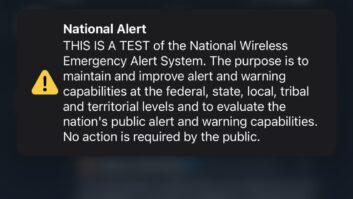Text has been updated with a comment from FEMA.
Last week’s national EAS and WEA tests came with a twist: For many Americans, the phone alerts arrived two minutes earlier than the EAS broadcast test came through.
The tests were scheduled that way from the start, as we reported in a preview story; indeed our own Radio World contributor Dan Slentz flagged that two-minute difference to me at the time, telling me he thought it wouldn’t be a great look for radio if EAS alerts didn’t arrive until minutes later than the wireless ones.
His was the only eyebrow raised at the time, at least in my circles. And a subsequent email to me from FEMA stated that “Both tests are scheduled to begin at approximately 2:20 p.m. ET” (italics are mine). Other public-facing announcements used similar language.
The 2:20 time is what many people remembered, and on the day of the test, the apparent two-minute lag between cell and broadcast alerts caused a lot of notice online.
As we reported last week, social chatter assumed the test had been sent early, given that the government had been emphasizing that 2:20 p.m. deployment time in its tweets. The phrase “Two Minutes Early” could be found trending on Twitter/X that day with plenty of snarky images and comments about government not being able to deliver an alert test as scheduled.
But it was not the first time the tests were deployed this way.
“Per our standard practice, FEMA activated the WEA portion of the test at 2:18 p.m. ET and the EAS portion at 2:20 p.m. ET,” IPAWS Director Antwane Johnson replied when I emailed FEMA for comment. “This was the exact same procedure used during our tests in 2021 and 2018, which also included a two-minute delay between the WEA and EAS activation. Due to the mechanics of sending these two different alerts, we are unable to execute them both simultaneously as they contain different information and elements.”
Good to know. In hindsight it does appear that the difference in times could have been communicated better, although one might also say that this is exactly why we do tests, to discover this kind of issue.
An anecdote from Rob Bertrand, senior director of technology for public station WAMU in Washington, illustrates the potential for confusion.
“An issue we had with the WEA alert arriving two minutes before the EAS alert was that it activated the cell phone of the on-air announcer (even though his phone was on silent, of course),” he wrote.
Rob said the announcer was working with an open mic at that moment and heard the tones from his cell phone in his headphones and thought they were the broadcast EAS.
“To his credit, in the confusion of the moment he sort of ad-libbed the EAS test copy in the quiet space around the cell phone tones,” Rob told me.
“Not long after he finished his ad-lib, the ‘real’ test came in and of course took over the signal. It didn’t sound great on the air, for sure. But on a purely technical level, the test passed with flying colors.”
Rob suspects that any news/talk station or even a music station that happened to have a mic open at that moment faced similar challenges.
“Not sure why the WEA alert preceded broadcast by two minutes, but I hope that in the future (and in the event of an actual emergency) that the tests are sent simultaneously to avoid this issue. I can’t imagine that WAMU was alone in this studio kerfuffle.”











